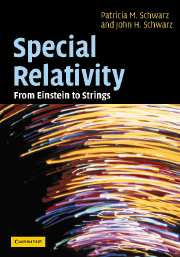Book contents
- Frontmatter
- Contents
- Preface
- Part I Fundamentals
- 1 From Pythagoras to spacetime geometry
- 2 Light surprises everyone
- 3 Elements of spacetime geometry
- 4 Mechanics in spacetime
- 5 Spacetime physics of fields
- 6 Causality and relativity
- Part II Advanced Topics
- Appendix 1 Where do equations of motion come from?
- Appendix 2 Basic group theory
- Appendix 3 Lie groups and Lie algebras
- Appendix 4 The structure of super Lie algebras
- References
- Index
2 - Light surprises everyone
Published online by Cambridge University Press: 06 July 2010
- Frontmatter
- Contents
- Preface
- Part I Fundamentals
- 1 From Pythagoras to spacetime geometry
- 2 Light surprises everyone
- 3 Elements of spacetime geometry
- 4 Mechanics in spacetime
- 5 Spacetime physics of fields
- 6 Causality and relativity
- Part II Advanced Topics
- Appendix 1 Where do equations of motion come from?
- Appendix 2 Basic group theory
- Appendix 3 Lie groups and Lie algebras
- Appendix 4 The structure of super Lie algebras
- References
- Index
Summary
Hands-on exercise: wave and particle properties
The purpose of this exercise is for you to observe some basic wave and particle properties. To complete this exercise you will need the following:
Tub of water, or access to a quiet pond, lake or swimming pool.
Things to float on the surface of the water.
Pen or pencil and some drawing paper.
Small projectile such as a stone.
Disturb the middle of the tub just until you are able to make a visible wave on the surface. Watch how the wave propagates. Wait until the surface of the water returns to being flat and make another wave. Keep doing this as many times as necessary to be able to draw what you see on the paper and answer the following questions:
Does the wave have a definite location at any one moment in time?
Does the wave have a definite direction as it propagates?
Approximately how far does the wave travel in 1 s?
Describe the motion of the water in which the wave moves.
Throw your small projectile in the air at various angles, letting it drop down (not in the water). Keep doing this as many times as necessary to be able to draw what you see and answer the following questions:
Does the object have a definite location at any one moment in time?
[…]
- Type
- Chapter
- Information
- Special RelativityFrom Einstein to Strings, pp. 21 - 54Publisher: Cambridge University PressPrint publication year: 2004

